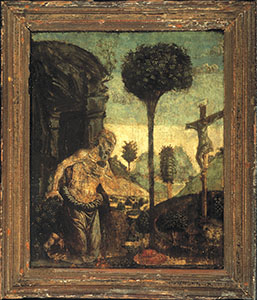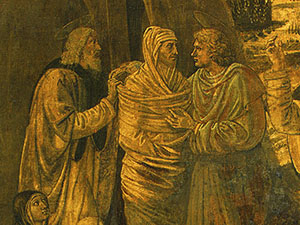
Saint Jerome the Penitent, Bardini Museum, Florence.

Resurrection of Lazarus, detail, National Gallery of Art, Washington.
The return of Benozzo to his native city followed closely on the political events of the Florence of 1494. This turmoil was felt in the neighboring areas controlled by the city and involved Pisa, as well, where the artist had lived since 1467: nevertheless, the painter - at this point highly esteemed and loved by the people of Pisa - managed to remain in the city until 1495.
Once he had returned to Florence, he probably assimilated the profound ideological changes that were asserting themselves in the city through the public sermons of Friar Savonarola and the expulsion of the Medici family. The Friar’s sermons attacked the generalized corruption that had prevailed in the city over the years and prophesized the coming of divine punishment. After the removal of Piero de' Medici – who had assumed leadership after the death of Lorenzo the Magnificent – Savonarola played a considerable role in politics and reorganized the power structure to incorporate the middle class, which had enjoyed no rights during the Medici dynasty. First and foremost, according to the Friar, politics had to be submitted to religion, but Pope Alexander VI was opposed to this idea. He understood it as an attempt by the Friar to keep Florence from supporting the Holy League that had been created to kick Charles VIII out of Italy. In order to reduce the considerable influence that the Friar held over the city, the Pope forbade Savonarola from preaching. Although this prohibition was followed by his excommunication in 1497, he continued even more violently with his campaign against the vices of the Church, creating numerous enemies as well as new admirers, even outside of Florence.
In the mean time the Medici supporters had regrouped, and in 1498 they had him arrested, tried for heresy, tortured, stoned, hung and then burned in Piazza della Signoria together with two of his most faithful followers, thus closing this season of the Florentine republic.
Benozzo had come into contact with the doctrine of the reformed mendicant orders (Augustinians, Dominicans, Franciscans) on more than one occasion. At an advanced age, his last works showed a deep sense of a severe and impassioned spirituality that clearly resonated with the sermons of Savonarola and can be witnessed in two oil paintings commissioned by the Pistoia Episcopal palace for Bishop Pandolfini - the Deposition (preserved in Florence’s own Museo Horne) and the Resurrection of Lazarus (National Gallery of Washington). The oil technique, already being practiced in Flanders, began to spread to Italy in the fourteen-sixties.
The large canvas of the Deposition testifies to this deep sharing of Savonarolian precepts - the painter renounced all types of ornamentation - a distinguishing feature of his style up to then - in order to avoid distracting the viewer from the drama of the sacred episodes themselves.
In 1497 (perhaps concurrent with the election of his son Giovan Battista as citizen judge), Benozzo moved to Pistoia. There is no doubt that the painter’s prestige was recognized throughout the entire territory of Tuscany. In the city, he was officially recruited to paint the entire wall of the Council Chamber of Town Hall. On 4th October of the same year, unfortunately, Benozzo Gozzoli passed away before he could complete this fresco.
The two canvases cited above plus a votive table are undoubtedly attributable to this period. The votive table is now at the Bardini Museum in Florence, and may have been executed for Friar Gerolamo di Michele Barbieri, Prior of the Convent named after Saint Jerome, the saint depicted with minutiae and precision in this little alterpiece.
Serena Nocentini